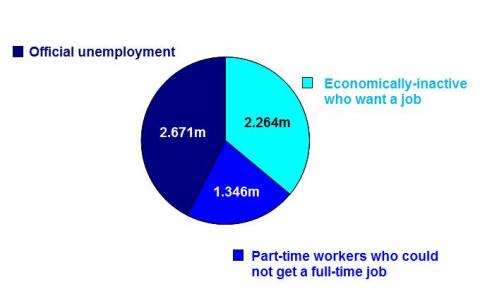Is 'true' unemployment 6.3 million in the UK?
Yesterday the Trades Union Congress (TUC) made headlines with its claim that 'true' unemployment in the UK could be as high as 6.3 million if different measures are used. General Secretary Brendan Barber commented on the matter:
"The headline unemployment figures are bad enough, but the true scale of joblessness is even worse. Over six million people are either out of work or under-employed. Tackling this crisis should be the government's number one priority"
The ONS Labour Force Survey (LFS) currently places the total UK unemployed at 2.671 million from October to December last year, although at the time of the TUC release it was measured at 2.685 million for September to November 2011.
The TUC release itself outlines the details behind the claims. They claim that, while the UK simply measures 'unemployment' or the number of individuals claiming Jobseeker's Allowance (the 'Claimant Count'), the US compiles a 'U6' measure of unemployment which includes 'discouraged', 'marginally attached' and 'under-employed' workers.
Join 72,953 people who trust us to check the facts
Sign up to get weekly updates on politics, immigration, health and more.
Subscribe to weekly email newsletters from Full Fact for updates on politics, immigration, health and more. Our fact checks are free to read but not to produce, so you will also get occasional emails about fundraising and other ways you can help. You can unsubscribe at any time. For more information about how we use your data see our Privacy Policy.
By applying these additional criteria to the UK measure, the TUC find the figure of 6.337 million as the U6 unemployment rate for the UK.
How the calculations add up
The US definition of U6 unemployment comprises three basic figures:
1) The official rate of unemployment (US)
2) People marginally-attached to the labour market
3) People employed part-time for economic reasons
While the UK equivalents are not precise, the TUC used the following ONS measures in their calculation:
1) The official rate of unemployment (UK) (aged 16+)
2) People economically inactive who want a job (aged 16-64)
3) Part-time workers who could not find a full time job
Using data from September to November last year, the official level of unemployment stood at 2.685 million. The number of people economically inactive who 'wanted a job' according to the survey was 2.273 million. Finally, the number of part-time workers who 'could not find a full-time job' in the survey stood at 1.311 million.
This gives a U6 unemployment amount for the UK of 6.269 million people. The 6.337 million figure was arrived at by adding to this the number of economically inactive people whose reason for being such was that they were 'discouraged workers'. This totalled 68,000 people or 0.068 million.
However after consulting with the ONS it became clear that the category for discouraged workers was already included in the economically inactive statistics and hence these 68,000 extra people 'did not exist' as an addition to the measure. The TUC confirmed that this was mistakenly added.
The headline figure however remains that, on the U6 measure, approximately 6.3 million people are defined as unemployed.
Updating these figures using statistics released today covering October to December last year gives only a marginal difference. By these figures the TUC's U6 measure stands at 6.281 million. The TUC's measure using the updated figures is illustrated:

What the measures mean
The TUC informed Full Fact that they would like to see a U6-equivalent measure complied for UK statistics. The thrust of their argument was that it is more indicative to consider not only those who are unemployed but also those who are economically inactive but are seeking a job.
The ONS's current unemployment measures are explained in detail in this document.
The official unemployment rate only counts those in the 'unemployed' category of this chart. But as is apparent, simply not being in employment does not necessarily mean a person is 'unemployed'. They could be economically inactive.
A person is economically inactive if they are not employed or unemployed. Hence if they do not have a job they must not fall into the definition of 'unemployed', which the ONS outlines:
"Unemployed people in the UK are:
1) without a job, have actively sought work in the last four weeks and are available to start work in the next two weeks, OR:
2) out of work, have found a job and are waiting to start it in the next two weeks"
The TUC's measure seems to be an attempt to bring out this category of economically inactive people who 'want a job'. In addition they see people who work part-time because they cannot get a full-time job as a similar category that should be included.
In some sense, therefore, they are expanding the definition of unemployment to include 'under employed' people. A similar approach has been taken by Eurostat.
Full Fact consulted the ONS on the calculations. They pointed out that the TUC use the terms 'unemployment' and 'joblessness' in a broader sense than used by their own statistics. However they were entitled to do so provided they adequately define the terms they are using.